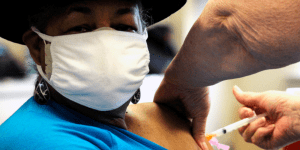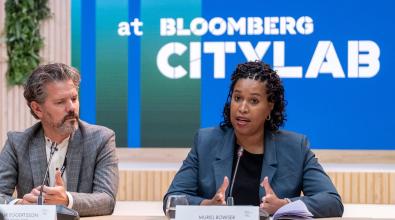Vaccines: How cities can support (and fix) rollout efforts

(AP Photo/Jay Reeves)
Over the past 10 months, Burlington, Vt., Mayor Miro Weinberger has repeated a motto that’s guided his city hall throughout the COVID-19 crisis: “In a global pandemic, local actions matter.” And his words have proven to be much more than lip service: Whether it was investing in local mask manufacturing or doubling down on local testing capacity, Burlington’s efforts have helped the city hold the line against the virus and maintain one of the lowest overall infection rates in the country.
Now, Weinberger hopes his city of 43,000 can carry that momentum over to the effort to get residents vaccinated—even though, like most U.S. mayors, he’s not exactly in the driver’s seat on the matter. Burlington does not have its own health department. Many critical decisions are made at the state or county level, not by city hall.
Still, Weinberger is finding important roles for city government to play. He meets every week with the state health commissioner and advocates for Burlington’s interests. That’s helped ensure that Burlington, as Vermont’s largest city, gets its fair share of vaccine. It also helped ensure that the city’s first publicly run vaccination site was located in a spot that was within walking distance for many low-income residents.
The city has also hired a team to lead outreach in refugee communities, to spread the word about the vaccine in Nepali, Somali, and five other languages, and to listen to residents’ needs and concerns. A similar team is working in American-born communities of color. “We’re using everything we can think of,” Weinberger said. “There are communication barriers and legitimate cultural concerns about the way BIPOC communities have been treated in the past … so we’re hitting it from a number of places.”
Cities across the country are ramping up similar efforts to give a local boost to what, so far, has been a halting national vaccination campaign. While mayors can’t do anything to fix the current scarcity of vaccines that has resulted in long lines at clinics and overwhelmed websites for scheduling appointments, they’re finding ways to beef up local distribution systems. The goal: to vaccinate residents at full speed and with equity front-and-center as supply catches up with demand.
A new COVID-19 Vaccine Toolkit from Bloomberg Philanthropies and the U.S. Conference of Mayors lays out the critical steps mayors can take to get there. One of the toolkit’s module focuses on the role mayors can play in the vaccination rollout, a second outlines data and monitoring strategies, and a third covers public engagement and communications. Additional resources to support city leaders are coming soon.
“Mayors know their cities better than anyone,” said Ryan Whalen of Bloomberg Philanthropies. “They’re well positioned to help vulnerable populations overcome barriers to getting vaccinated, and partner with trusted local voices to encourage uptake.”
[Get all our vaccine resources for mayors here]
In Louisville, Ky., Mayor Greg Fischer says that after almost a year of playing defense against COVID-19, “we’re finally on the offense, and it feels great.” Back in December, Fischer organized a pair of task forces to coordinate the local vaccination effort, one focused on hospitals, pharmacies, and other distribution partners, and a second focused on coordinating with state and federal government. The city, which runs its own health department, expects to administer nearly 9,000 doses this week at a local arena. “We could use three or four times the amount of vaccines we’re getting right now,” Fischer said, “but we’re preparing for when that happens so we scale up from one mass vaccination site into many other small sites.”
Fischer, who also serves as president of the U.S. Conference of Mayors, urges mayors to be thinking ahead. “The mayor has got to go from the present to be thinking out six to eight weeks from now, when, I hope, supply starts to equal demand and maybe exceed it after that. And then, how do you make sure you’re touching all parts of your community and using data to make sure that you’re in the right place and that you’ve got proper resources behind that?”
In Dayton, Ohio, Mayor Nan Whaley is leveraging communications channels built during the pandemic to push for an equitable vaccine rollout. Since early 2020, she and county health officials have convened a weekly Friday morning call with clergy, including leaders of a number of Black churches in West Dayton. Those calls began to focus on ways to overcome vaccine hesitancy among some residents and ensure that eligible residents have access to a shot if they want one.
As a result of these conversations, a vaccine clinic at a predominantly Black church is now administering a quarter of the local health department’s doses. Rather than assigning appointments through an online free-for-all, most people at this point are coming in through informal outreach channels such as church secretaries calling up elderly parishioners and encouraging them to come in.
“We’ve had these relationships before,” said Torey Hollingsworth, a senior policy aide to Mayor Whaley. “But we’ve really deepened them through the pandemic and are trying to deploy them to make sure that folks who may not have easily found their way into the early rounds of vaccination have that access.”
[Get the latest innovation news from Bloomberg Cities! Subscribe to SPARK.]
In Baltimore, city leaders are preparing to roll out a pilot program that will train residents to serve as ambassadors who can talk to neighbors and friends about getting vaccinated and help combat misinformation. Baltimore also is getting ready to launch mobile vaccination clinics at senior housing and other locations, in partnership with Johns Hopkins University and MedStar Health.
The clinics will build on lessons learned from more than 100 mobile flu vaccine clinics Baltimore held late in 2020. A big lesson was the need to visit vaccination locations in advance to get word out about the clinic and answer any questions people have. “There’s not only high levels of vaccine demand right now but also vaccine hesitancy,” said Adam Abadir, a spokesperson for the Baltimore City Health Department. “We want to make sure that we’re not forgetting about anyone as we work toward higher and higher levels of vaccination in Baltimore.”
New Orleans is also taking advantage of lessons learned last year, particularly with standing up COVID testing operations. Liana Elliott, Deputy Chief of Staff to Mayor LaToya Cantrell, said city leaders are looking closely at staffing mass vaccination sites so that a mix of city workers and volunteers can manage the logistics while leaving the medical tasks to licensed professionals. They’re also coordinating a shared waiting list for hospitals and pharmacies to dispense leftover “angel doses” so that those shots go to elderly residents standing by on call, rather than just anyone nearby.
City leaders are also ramping up outreach efforts through the “Sleeves Up, NOLA” campaign, featuring locals who in normal times would be celebrating Mardi Gras this time of year.
And leaders are working with state authorities to get the same granular data on vaccinations that they previously worked to get on COVID case rates and testing so that they can monitor progress of the vaccine rollout by demographics and geography.
“The experience is like deja vu all over again,” Elliott said, referring to what it was like setting up COVID testing last spring. “We were able to stand things up really quickly, get everything in place, and then the supply runs out, the demand is still there and we’re waiting and waiting. We know the floodgates will open again.”
